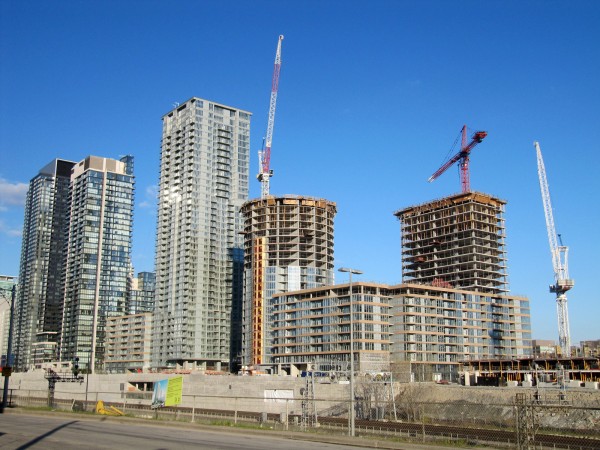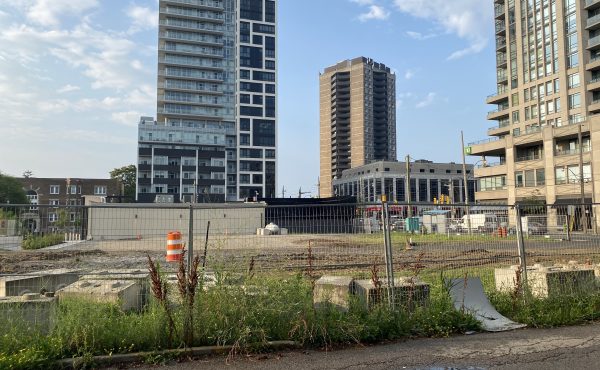Have you ever wondered why all the new development in Toronto is located downtown? Apart from the obvious reason that downtown real estate is more valuable, what is the major disincentive for developers to take their cranes east of the subway line, or further west for that matter? Surely there must be some socially responsible private developers in Toronto who aim at revitalizing and regenerating older communities in order to create new, vibrant, cohesive communities.
The truth of the matter is that there are indeed socially responsible developers in the city of Toronto, but it is our municipal and provincial policies that are partially responsible for stifling these companies from exploring development options away from the sea of glass towers. While it is great that Toronto has more “cranes in the sky” than any other North American city, one must ask themselves: are more one bedroom, 400 square foot condominiums really needed? What ever happened to life-cycle housing? Or affordable housing for that matter? Both public and academic rhetoric now highlights the income polarization, uneven development and burgeoning social, economic and political issues apparent in Toronto, which are creating a divided city. Urban revitalization is key to palliating many of these issues. Matters of affordable housing, disconnectivity, aging infrastructure, single-use zoning and a whole swath of social issues can be tackled through economically, socially and environmentally responsible and sustainable urban revitalization throughout the city of Toronto. Large pockets of the ‘post-war’, inner suburbs of Toronto are perfect candidates for this type of revitalization, but yet little development is taking place.
Development fees, Section 37, and the “100% replacement rate” are prime culprits for this reality. Unlike most metropolitan areas in North America, Toronto has a flat fee for development charges. Meaning that regardless if a developer decides to build on a parcel of land in the downtown core, or in an outer suburb of Scarborough, they are forced to pay the same development charge. This is economically illogical. Building in an area that is likely to return less on investment, while having the same expenses is not exactly an incentive for profit-driven companies.
In the same vein, have you ever wondered why all of the great amenities tend to be centered in downtown? Yes, every area needs amenities, services, and community centers, but shouldn’t we distribute some of the goods? Outer suburbs are faced with poor transit, lacking social services, a dearth of public, green space and community facilities, yet these areas continue to decline. This is largely connected to the development fees policy in place.
However, coupled with this is the infamous Section 37. Section 37 is essentially provincial policy that stipulates that in return for greater height or density, developers can provide extra funds to compensate for the increased ‘strain’ the development will place on resources and services in the area. These Section 37 negotiations can result in various amounts of extra money, and can land neighborhoods anything from public pools to more bus shelters. This sounds pretty good to most people, and it is to a certain extent; however Section 37 stipulates that these extra funds must be geographically connected or contiguous to the development. Meaning that these funds cannot be dispersed around the city, hence the problem. Purportedly, if we were able to disperse these funds to areas of the city in need to regeneration, we may realize a much more egalitarian city, not typified by stark dichotomies.
As one of the only Westernized countries in the world that does not have a national housing strategy, the “100% replacement rate” seems like a good strategy to maintain affordable housing. After all, this law outlines the need for developers to maintain the same number of affordable rental units pre-development as post-development. The aim is obviously to protect the limited affordable housing left in the city, while trying not to increase the 10-year wait for affordable housing. Unfortunately, this presents another disincentive for developers to build in certain areas, namely those inner suburbs. In order for developers to get a return on investment, the new rental units would have to come in at cost, which is highly unlikely when considering this type of massive upgrade. This is not usually plausible without increasing density and height further, which is often opposed by local communities or not permitted under other provincial and municipal framework. Similarly, while it is important for developers to be socially responsible, and without private-public partnerships the current state of the city would be much more dire, one needs to rethink the question. Shouldn’t we as a community, city, province, and country be tackling the covert and overt issues leading to a dearth of affordable housing and increasing income polarization rather than placing this responsibility on the backs’ of developers?
photo by Loozrboy
Kayla is an urban studies student at the University of Toronto





9 comments
more drivel.
Interesting points.
This issue is so massive that spacing could have a perpetual weekly article on what’s wrong with development in Toronto! I would rather not use the word, “wrong” though. I think that just perpetuates the public distaste for condos that is driven by conservative single-family home owner bias. Density has a lot of sustainable benefits, it’s more a matter of finding the amount of density in the right location, there are locations where high-density is definitely appropriate.
Of course there’s also the NIMBY factor in older inner-suburb neighbourhoods. This means that redevelopment consists of individual bungalows being knocked down and replaced by generic cheap stone-veneered houses that could be in Thornhill or Milton or Whitby or just about anywhere.
I can’t agree that Section 37 funds should be decoupled from the local area of the development. It’s just more incentive for NIMBYs that way–“We get this big development we don’t want, and some distant poor neighbourhood will get a community centre? Fie on that!”
It’s the local councillor’s job to negotiate Section 37 stuff. If you disentangle Section 37 funds from the local area, then all the negatives of the deal would happen in the councillor’s ward while the benefits would accrue elsewhere. This would eliminate any incentive the councillors have to agree to Section 37 exemptions. Instead of the local area getting something, no one would get anything.
To be clear in my previous comment, instead of larger-scale, well-planned redevelopment of older inner-suburb neighbourhoods, it’s totally ad-hoc additions of (in my opinion) totally out-of-character, generic developer-grade houses on whatever lots that become available (often due to an estate sale).
I’ve always thought that the area along Pape Ave between O’Connor and Cosburn (or even down to Mortimer) would be perfect for redevelopment including a portion of affordable housing units. Now I know why it isn’t happening. I guess the only way this area will be redeveloped is if the DRL is built under Pape Ave, and that is 20 years away at this point. Pity.
While development fees may be a disincentive to development in general, I can’t see any bias toward downtown. If anything, they favour the suburbs, with a substantial portion of the fees funding the Spadina Subway extension, and with storm-water fees based on number of units rather than on lot area. Section 37 is also a non-factor. Beside the political reasons that others have mentioned, the whole point of the program is to pay for the city amenities that the new residents will actually use, so they don’t end up overwhelming the existing programs and facilities in their area.
A far bigger factor is noted only as an aside: nimby pressure from neighbours who don’t want redevelopment near by, in their suburban neighbourhoods. The cost of dealing with the inevitable nimby fight is substantial, and it’s a more formidable roadblock to the small-scale developer who wants to build a 12-unit building than to the big corporate developers who build 40 stories high.
The article seems to get development charges backwards. Development charges are designed to collect money for the capital improvements that the city has to pay for service a particular development. These improvements include roads, sidewalks, water and sewers. In many cases the capital improvements are paid for by the developers and then the city assumes them (takes over responsibility for maintenance) after the development is finished. Development charges are also supposed to pay for the costs of services that will be under increased demand (transit, police, fire department, library and waste collection) after the development is finished.
The key is that these capital improvements and services are more cost-effective to provide in denser areas. They are more expensive to provide in less dense areas. Imagine the cost of building or maintaining streets in a downtown neighbourhood where every lot is 20′ wide, vs. a suburban neighbourhood where lots are 60 feet wide. In the downtown neighbourhood, you have more taxpayers served per metre of road. There are more taxpayers paying the upkeep per metre of road then in the suburban neighbourhood. The same principle applies for things like fire services. So development charges should reflect costs, and suburban neighbourhoods are more costly to service than dense neighbourhoods, so development charges should be *higher* in suburban neighbourhoods. In fact, development in dense neighbourhoods in Toronto is unfairly penalized vs. development in less-dense areas of the city because the development charges do not vary with density, instead as the author mentioned they are charged on a per-unit basis.
“Perverse Cities” by Pamela Blais is an interesting overview of how dense neighbourhoods are overcharged and less-dense neighbourhoods are undercharged by development charges.
The whole point of section 37 money is that it compensates a community for having developers over-build in their area. It is often used to provide benefits that help absorb the new population (for example, creating or fixing up park space). It makes no sense to distribute this compensation to areas that are not suffering this development pressure. There are a lot of problems with how section 37 works, but spending it locally is not one of them.
If other parts of the city are neglected, that’s because we as a population have chosen not to pay high enough taxes to properly maintain and improve our city. It has nothing to do with section 37.
Development charges, by contrast, don’t have to be spent in the area where they were raised (even though, in some cases, those areas do need additional infrastructure), so there is plenty of distribution of the benefits of development around the city through them.